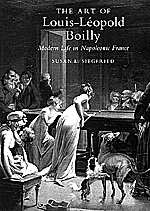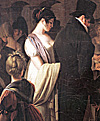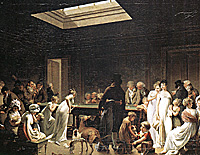 Author: Susan L. Siegfried
Author: Susan L. Siegfried
Pages: 238
Illustrations: 84 black and white and 84 color reproductions of period paintings and illustrations.
Maps: 1, showing Boilly's residences in Paris.
Footnotes: 472, most annotated, presented by chapter at the end of the book.
Appendices: None
Bibliography: None, but there is a list of 20 Abbreviations and Frequently Cited Sources, and additional sources are found in the footnotes.
Index: 727 entries
Publisher: Yale University Press, New Haven, Connecticut
Publication Date: 1995
Binding: Cloth (hardbound)
ISBN: 0-300-06332-6
Price: $55.00
Summary: The Art of Louis-Leopold Boilly (pronounced bwah-yee) discusses the work of this lesser known French artist (1761-1845) in context of the periods during which he painted. The author particularly focuses on the period of the Directory and the early years of the Napoleonic Empire. The book explains how Boilly's specialty, genre painting, depicted a fairly accurate representation of his world. This is an art history book: By studying Boilly's works, one may learn not only about the changes in the social fabric in France, but in particular how those changes affected one specific segment of the population.
Susan L. Siegfried, research projects manager at the Getty Art History Information Program at the J. Paul Getty Museum in Santa Monica, California, chose to analyze Boilly as an outgrowth of her belief that the works of lesser known artists were at least as important, and were possibly "more eloquent as visual testimony of the past", as the works more commonly studied in mainstream "high art". Her analysis concentrates on the more ambitious works Boilly produced from the mid-1790's until 1824. Siegfried wrote this volume to elucidate an exhibition on Boilly's art for the National Gallery of Art in Washington, D.C. and the Kimball Museum in Fort Worth, Texas, which the author helped to organize.
Boilly has been called "the most significant painter of everyday life in Napoleonic France". His portraits and genre scenes provide charming illustrations of the period. Author Siegfried argues that Boilly's paintings should be read not just for their documentary detail but also for their wider cultural significance.
According to Siegfried, Boilly viewed the Revolution not as a political event but as a force that redefined social attitudes and behavior. His paintings of street scenes contained a new middle class. They also reveal his distinctive interest in the act of viewing which Siegfried contends represent peculiarly modern politics of spectatorship. In fact, the author feels that Boilly's representation of women and boys as highly eroticized objects raises important issues of viewing and gender.
Boilly was 28 years old in 1789 (whereas Jacques-Louis David was 41) when the Revolution occurred. Boilly, who was seven years older than Bona-parte, lived twenty more years after David, witnessing the Revolution of 1830 and the July Monarchy.
The book is divided into six chapters. In the first, "Persona and Status", Siegfried discusses the beginning and ending of Boilly's career. When Boilly moved to Paris in 1785, he was a self-taught painter from Arras who specialized in the stock in trade of most genre painters -- the gallant picture (slightly risque scenes of seduction). At the end of his painting career he had changed his subject matter to modern urban public spectacles. This shift can, at least in part, be attributed to a paradigm shift from the private to the public in social forms.
"An Artist Negotiates the French Revolution", the second chapter, explains how Boilly adapted his painting style and his subject matter to the changing society during and after the French Revolution. Prior to the Revolution wealthy aristocrats commissioned Boilly's gallant pictures and were the mainstay of his income. He adopted new strategies for exhibition, patronage, and subject matter due to the changes brought by the Revolution, and participated in public exhibitions, sold his works publicly and through galleries, and dealt with subjects of more social import. In particular, The Triumph of Marat, perhaps Boilly's most significant painting, was done during this time.
The third chapter, "Immorality and the Directoire", concentrates on a group of ten significant paintings which Boilly produced between 1795 and 1804. With these paintings he moved the immorality that has been seen to characterize the Directory from behind closed doors into the public eye. Topical social issues such as prostitution, food shortages, and speculation and gambling were introduced into the public domain as subjects for art.
The emphasis of Chapter 4, "Portraiture and Identity", discusses how Boilly's portraits after the French Revolution emphasized the public roles of his subjects by incorporating staging -- social context and indicators of class and profession. In particular, he represented artists as famous, important men, with audiences implied or depicted in the paintings. Boilly's new interest in the staging of his portrait paintings was consistent with 18th Century emphasis on social position and identity.
"Spectacle and Leisure", the fifth chapter, explains how leisure became an important preoccupation in post-Revolutionary France, especially for the middle class. Boilly's approach to leisure, however, does not concentrate on the normal perception of it, but instead on the ambiguities and contradictions.

 The author illustrates her points primarily by comparing and contrasting two specific paintings of Boilly's, "A Game of Billiards" (1808) [at right] and "The Entrance to the Turkish Garden Cafe" (1812) [detail at left], both exhibited in government salons.
The author illustrates her points primarily by comparing and contrasting two specific paintings of Boilly's, "A Game of Billiards" (1808) [at right] and "The Entrance to the Turkish Garden Cafe" (1812) [detail at left], both exhibited in government salons.
The sixth and final chapter, "Viewing and Spectatorship", looks at the way in which Boilly depicted the act of people viewing things and other people. "[S]elf-consciousness about ways of picturing the world", which had been important enough in the 17th Century, had increased in importance during the 18th Century. Three areas where this is sharply defined in his paintings are presentations of viewing as an activity, depictions of women, and representations of inanimate objects (particularly trompe l'oeil pieces).
Boilly emerges in this innovative study as an intriguing figure who fashioned new pictorial formulas that appealed to connoisseurs of his era. Unable to gain the patronage of Napoleon (he was not a neo-classicist like David), he thrived anyway: Boilly claimed to have done more than 5,000 portraits!
Siegfried firmly places Boilly's work in a social context: She relates his paintings not only to the conditions present during Boilly's lifetime, but also to those preceding and following them. Because it studies these conditions from the perspective of an artist, The Art of Louis-Leopold Boilly may not appeal to everyone studying the Napoleonic era, but it will certainly complement and enrich any library devoted to that subject.
Related:
More Napoleonic Library
Back to Table of Contents -- Napoleon #10
Back to Napoleon List of Issues
Back to MagWeb Master Magazine List
© Copyright 1997 by Emperor's Press.
This article appears in MagWeb (Magazine Web) on the Internet World Wide Web.
The full text and graphics from other military history magazines and gaming magazines are available at http://www.magweb.com